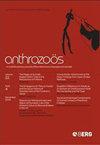兽医对伴侣动物安乐死态度的跨文化研究
IF 2.3
2区 农林科学
Q2 SOCIOLOGY
引用次数: 0
摘要
摘要采用在线问卷调查匈牙利(n = 93)、瑞典(n = 145)和约旦(n = 40)的兽医对伴侣动物安乐死的态度。问题涉及实施安乐死的次数、原因和情况、兽医对四个临床病例的意见,以及与安乐死相关的精神负担(使用7分李克特量表)。兽医每月实施安乐死的次数与国家显著相关(瑞典最高),但与年龄组(≤34岁、35-54岁、≥55岁)或性别没有差异。在所有国家,无法治愈的疾病是安乐死最常见的原因,但在瑞典,年老也是一个重要因素。瑞典的受访者最有可能满足对攻击性但健康的动物实施安乐死的要求,而约旦的受访者则最不可能。据报道,安乐死的精神负担在瑞典最低,在约旦最高,男性兽医的负担比女性兽医低。主人对他们的动物的依恋与被调查者所经历的安乐死的伦理负担无关。每月实施更多安乐死的兽医报告道德负担较低。大多数受访者认为他们在大学教育期间对这一主题的了解不足。根据我们的模型,兽医对安乐死的态度与个人(性别、年龄、培训背景)和社会(文化、宗教背景)因素相结合。进一步研究这一主题是很重要的,不仅对动物福利规则和实践,而且对保护兽医的心理健康。关键词:态度、跨文化伦理、安乐死、人与动物互动、兽医披露声明作者未报告潜在的利益冲突。该项目由欧盟支持,欧洲社会基金共同资助:EFOP-3.6.3-VEKOP-16-2017-00005“通过支持学生的学术研讨会和项目,制定指导过程来加强科学替代。”本文章由计算机程序翻译,如有差异,请以英文原文为准。
A Cross-Cultural Study of Veterinarians’ Attitudes to the Euthanasia of Companion Animals
ABSTRACTThe attitudes of veterinarians to the euthanasia of companion animals were investigated using an online questionnaire in Hungary (n = 93), Sweden (n = 145), and Jordan (n = 40). The questions concerned the number of euthanasia performed and the reasons for and circumstances surrounding them, the veterinarians’ opinions on four clinical cases, and the mental burden associated with euthanasia (using a 7-point Likert scale). The monthly number of euthanasia performed by the veterinarians was significantly related to the country (highest in Sweden), but no differences were found by age group (≤ 34 years, 35–54 years, ≥ 55 years) or gender. Untreatable conditions were the most common reason for euthanasia in all countries, but old age was also an important factor in Sweden. Swedish respondents were the most likely, and Jordanians the least likely, to fulfill euthanasia requests about aggressive, but otherwise healthy, animals. The reported mental burden of euthanasia was lowest in Sweden and highest in Jordan, and male veterinarians reported a lower burden than female veterinarians. The attachment of owners to their animals was not associated with the ethical burden of euthanasia experienced by the respondents. Veterinarians who performed more euthanasia per month reported a lower ethical burden. Most respondents considered what they had learned about the topic during their university education to be insufficient. According to our model, veterinarians’ attitudes toward euthanasia are associated with a combination of personal (gender, age, training background) and social (cultural, religious background) factors. Further research on this topic is important, not only for animal welfare rules and practices but also for the protection of veterinarians’ mental health.KEYWORDS: Attitudescross-culturalethicseuthanasiahuman–animal interactionveterinarian Disclosure StatementNo potential conflict of interest was reported by the authors.Additional informationFundingThe Project was supported by the European Union and co-financed by the European Social Fund: EFOP-3.6.3-VEKOP-16-2017-00005 “Strengthening the scientific replacement by supporting the academic workshops and programs of students, developing a mentoring process.”
求助全文
通过发布文献求助,成功后即可免费获取论文全文。
去求助
来源期刊

Anthrozoos
农林科学-兽医学
CiteScore
3.40
自引率
18.80%
发文量
43
审稿时长
>36 weeks
期刊介绍:
A vital forum for academic dialogue on human-animal relations, Anthrozoös is a quarterly, peer-reviewed journal that has enjoyed a distinguished history as a pioneer in the field since its launch in 1987. The key premise of Anthrozoös is to address the characteristics and consequences of interactions and relationships between people and non-human animals across areas as varied as anthropology, ethology, medicine, psychology, veterinary medicine and zoology. Articles therefore cover the full range of human–animal relations, from their treatment in the arts and humanities, through to behavioral, biological, social and health sciences.
 求助内容:
求助内容: 应助结果提醒方式:
应助结果提醒方式:


